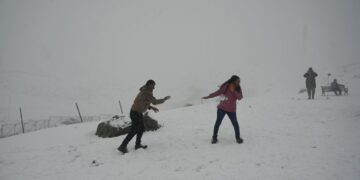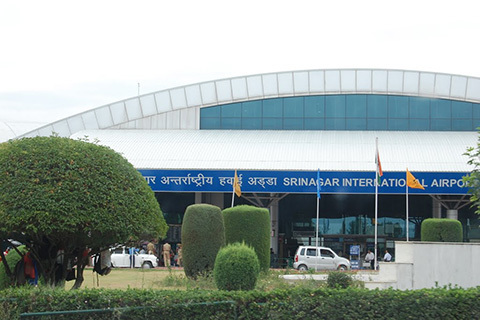Srinagar: Even as minimum temperatures rose slightly during the preceding night, dense fog affected operations at Srinagar airport on Friday as visibility fell to about 300 metres, officials said.
They said the thick layer of fog that engulfed Kashmir hit air traffic to and from the valley. Several flights were delayed while one was diverted as the visibility fell to about 300 metres.
visibility required to run flight operations is around 1,100 metres.
However, operations resumed around noon after visibility improved at the airport. The morning’s first flight landed in Srinagar at 11:48 am, the officials said.
They added that people also faced difficulties while commuting due to the fog.
The Met office said light snow at isolated higher reaches was possible on Friday.
On Saturday, a moderate to strong western disturbance is likely to affect Jammu and Kashmir and light to moderate snow at most places is possible, with the peak activity from Saturday night till Monday morning.
In a related development, the night temperature rose at most places in Kashmir.
Gulmarg resort in north Kashmir recorded a low of minus 4.5 degrees Celsius, up from the previous night’s minus 8.6 degrees, the Met office said.
Pahalgam in south Kashmir registered a minimum temperature of minus 4.6 degrees Celsius.
In Srinagar, the mercury settled at a low of minus 2.2 degrees Celsius against the previous night’s minus 2.6 degrees.
Qazigund, the gateway town to Kashmir, logged a minimum temperature of minus 7.3 degrees Celsius and was the coldest place in the valley, while Konibal in Pampore town recorded a low of minus 4.6 degrees.
Kupwara in north Kashmir registered a minimum temperature of minus 1.6 degrees Celsius while Kokernag in south Kashmir recorded minus 5.5 degrees.
Kashmir is currently under the grip of ‘Chillai-Kalan’ — the harshest period of winter — that began on December 21. During the 40 days of ‘Chillai-Kalan’, the chances of snowfall are the highest and the temperature drops considerably.
Srinagar administration issues advisory in wake of snow forecast
The district administration of Srinagar has issued an advisory in the wake of a forecast by the weather department Kashmir.
As per the advisory, the district administration has advised the people to follow safety guidelines issued by the District Disaster Management Authority (DDMA) and avoid unnecessary travel during adverse weather conditions to ensure safety and minimise disruptions.
The Srinagar administration has asked the MH&ED, PWD (R&B), SMC, KPDCL, Jal Shakti, Health and Medical Education departments to make necessary logistical arrangements for snow clearance and related works.
“The field staff of all these departments shall remain stationed in their headquarters to render immediate assistance,” the advisory reads.
The administration has also established a District Emergency Operation Centre (DEOC) and asked the public to contact the concerned department in case of emergency.
To approach District Emergency Operation Centre (DEOC) people can dial (0194-2483651, 0194-2457552 0194-2457543), MH&ED (0194-2497458), Srinagar Municipal Corporation (0194-2470466) R&B, Rajbagh (0194-2313751), Traffic Department 0194-2450022, Fire & Emergency Control Room (0194-2453224) Animal Husbandry Control Room (0194-2956201).
Earlier, the Director MeT Srinagar Mukhtar Ahmad said that there was a weather forecast of snowfall from January 4 to 6 of 2025 following which the department has already issued yellow and orange alerts for January 4 and 5 for some areas.
“There is a possibility of snowfall from January 4 to January 6 morning. The lower reaches will record moderate to heavy snowfall while in the upper reaches there are chances of heavy to very heavy snowfall,” he said.
He said Jammu plains will record rainfall during January 4 to 6 while Chenab areas will witness snowfall.
“The weather will remain dry from January 6 to January 10 with a cold wave coupled with dense from January 7,” Director MeT said.
He said they have already issued yellow and orange alerts in some districts keeping in view the accumulation of snow.
“There can be chances of snow avalanche in some areas while surface and air traffic may get disrupted on January 5,” he said.








